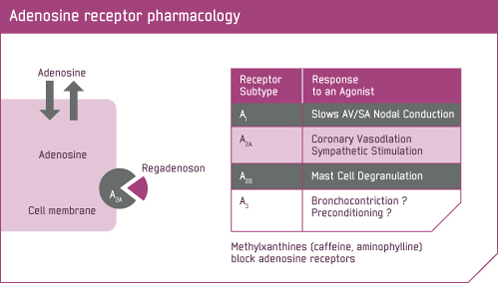Adenosine receptors pharmacology and rapiscan
Adenosine receptors occur throughout the body. Adenosine is a nucleoside and is known to act as an autocoid – that is, a small molecule hormone that acts upon the very same cells that produce it. 1,2
Adenosine is produced locally under conditions of uncommon stress and has been referred to as the retaliatory metabolite. 1,2
In the heart, the A2A adenosine receptor is responsible for coronary vasodilation resulting in an increase in coronary blood flow and is believed to cause sympathoexcitation, wheras the A1 receptor slows arterioventricular (AV) and sinoatrial (SA) nodal conduction.2-5
In the lung, the A2B and A3 adenosine receptors have been implicated in the pathophysiology of bronchoconstriction in susceptible individuals (i.e., asthmatics).2

Regadenoson is a low affinity agonist (Ki ≈ 1.3 μM) for the A2A adenosine receptor, with at least 10-fold lower affinity for the A1 adenosine receptor, and very low, if any, affinity for the A2B and A3 adenosine receptors.6
Despite low affinity for the A2A adenosine receptor, in animal models, regadenoson has high potency for increasing coronary conductance (an indirect measure of coronary blood flow velocity) and selectivity (≥ 215-fold) for increasing coronary conductance (A2A-mediated response) relative to slowing of cardiac AV nodal conduction (A1-mediated response) as measured by AV conduction time.6
Due to differences in receptor density and the selectivity of Rapiscan, in animals regadenoson was shown to preferentially increase blood flow in coronary relative to peripheral (forelimb, brain, pulmonary) arterial vascular beds.6,7
In a human clinical trial, Rapiscan was shown to cause a rapid increase in blood flow, which is sustained for several minutes - sufficient for radionuclide myocardial extraction.6,8
References
- Belardinelli L and Shryock JC. Does Adenosine Function as a Retaliatory Metabolite in the Heart? News in Physiological Sciences 1992; 7: 52-56.
- Jacobson MA. Molecular biology of adenosine receptors. In: Belardinelli L, Pelleg A, eds. Adenosine and Adenine Nucleotides: From Molecular Biology to Integrative Physiology. Norwell, MA:Kluwer Academic Publishers; 1995:5-13.15.
- Belardinelli L, Shryock JC, Snowdy S, et al. The A2A adenosine receptor mediates coronary vasodilation. J Pharmacol Exp Ther 1998;284:1066-1073.
- Shryock JC, Snowdy S, Baraldi PG, et al. A2A-adenosine receptor reserve for coronary vasodilation. Circulation 1998;98:711-718
- Dhalla AK, Wong M-Y, Wang W-Q et al. Tachycardia Caused by A2A Adenosine Receptor Agonists Is Mediated by Direct Sympathoexcitation in Awake Rats. JPET 2006; 316:695–702.
- Rapiscan Summary of Product Characteristics (Download)
- Zhao G, Linke A, Xu X et al. Comparative Profile of Vasodilation by CVT-3146 (regadenoson), a Novel A2A Receptor Agonist, and Adenosine in Conscious Dogs. JPET 2003; 307:182–189.
- Lieu HD, Shryock JC, von Mering GO, et al. Rapiscan, a selective A2A adenosine receptor agonist, causes dose-dependent increases in coronary blood flow velocity in humans. J Nucl Cardiol 2007;14:514-520. (View abstract)




